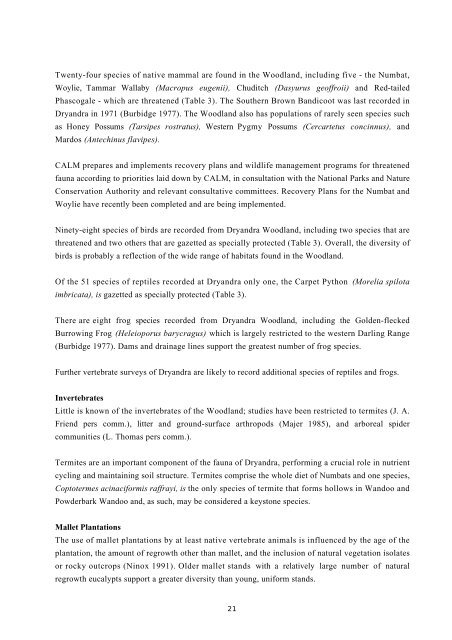Dryandra Woodland - Department of Environment and Conservation ...
Dryandra Woodland - Department of Environment and Conservation ...
Dryandra Woodland - Department of Environment and Conservation ...
Create successful ePaper yourself
Turn your PDF publications into a flip-book with our unique Google optimized e-Paper software.
Twenty-four species <strong>of</strong> native mammal are found in the <strong>Woodl<strong>and</strong></strong>, including five - the Numbat,<br />
Woylie, Tammar Wallaby (Macropus eugenii), Chuditch (Dasyurus ge<strong>of</strong>froii) <strong>and</strong> Red-tailed<br />
Phascogale - which are threatened (Table 3). The Southern Brown B<strong>and</strong>icoot was last recorded in<br />
<strong>Dry<strong>and</strong>ra</strong> in 1971 (Burbidge 1977). The <strong>Woodl<strong>and</strong></strong> also has populations <strong>of</strong> rarely seen species such<br />
as Honey Possums (Tarsipes rostratus), Western Pygmy Possums (Cercartetus concinnus), <strong>and</strong><br />
Mardos (Antechinus flavipes).<br />
CALM prepares <strong>and</strong> implements recovery plans <strong>and</strong> wildlife management programs for threatened<br />
fauna according to priorities laid down by CALM, in consultation with the National Parks <strong>and</strong> Nature<br />
<strong>Conservation</strong> Authority <strong>and</strong> relevant consultative committees. Recovery Plans for the Numbat <strong>and</strong><br />
Woylie have recently been completed <strong>and</strong> are being implemented.<br />
Ninety-eight species <strong>of</strong> birds are recorded from <strong>Dry<strong>and</strong>ra</strong> <strong>Woodl<strong>and</strong></strong>, including two species that are<br />
threatened <strong>and</strong> two others that are gazetted as specially protected (Table 3). Overall, the diversity <strong>of</strong><br />
birds is probably a reflection <strong>of</strong> the wide range <strong>of</strong> habitats found in the <strong>Woodl<strong>and</strong></strong>.<br />
Of the 51 species <strong>of</strong> reptiles recorded at <strong>Dry<strong>and</strong>ra</strong> only one, the Carpet Python (Morelia spilota<br />
imbricata), is gazetted as specially protected (Table 3).<br />
There are eight frog species recorded from <strong>Dry<strong>and</strong>ra</strong> <strong>Woodl<strong>and</strong></strong>, including the Golden-flecked<br />
Burrowing Frog (Heleioporus barycragus) which is largely restricted to the western Darling Range<br />
(Burbidge 1977). Dams <strong>and</strong> drainage lines support the greatest number <strong>of</strong> frog species.<br />
Further vertebrate surveys <strong>of</strong> <strong>Dry<strong>and</strong>ra</strong> are likely to record additional species <strong>of</strong> reptiles <strong>and</strong> frogs.<br />
Invertebrates<br />
Little is known <strong>of</strong> the invertebrates <strong>of</strong> the <strong>Woodl<strong>and</strong></strong>; studies have been restricted to termites (J. A.<br />
Friend pers comm.), litter <strong>and</strong> ground-surface arthropods (Majer 1985), <strong>and</strong> arboreal spider<br />
communities (L. Thomas pers comm.).<br />
Termites are an important component <strong>of</strong> the fauna <strong>of</strong> <strong>Dry<strong>and</strong>ra</strong>, performing a crucial role in nutrient<br />
cycling <strong>and</strong> maintaining soil structure. Termites comprise the whole diet <strong>of</strong> Numbats <strong>and</strong> one species,<br />
Coptotermes acinaciformis raffrayi, is the only species <strong>of</strong> termite that forms hollows in W<strong>and</strong>oo <strong>and</strong><br />
Powderbark W<strong>and</strong>oo <strong>and</strong>, as such, may be considered a keystone species.<br />
Mallet Plantations<br />
The use <strong>of</strong> mallet plantations by at least native vertebrate animals is influenced by the age <strong>of</strong> the<br />
plantation, the amount <strong>of</strong> regrowth other than mallet, <strong>and</strong> the inclusion <strong>of</strong> natural vegetation isolates<br />
or rocky outcrops (Ninox 1991). Older mallet st<strong>and</strong>s with a relatively large number <strong>of</strong> natural<br />
regrowth eucalypts support a greater diversity than young, uniform st<strong>and</strong>s.<br />
21

















